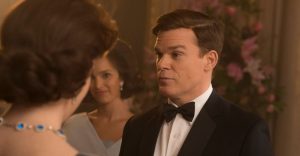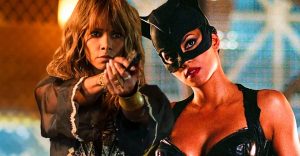10 Ways Galaxy 4 Will Be The Best Doctor Who Animation

Since 2006, the BBC have released a variety of animations based on Doctor Who‘s missing episodes. This all began with Cosgrove Hall’s animated reconstruction of episodes one and four of 1968’s “The Invasion,” which sees the Second Doctor and his companions, Jamie and Zoe, encounter the Cybermen on Earth.
Previously, these cartoons had been restricted purely to stories missing only two parts, but in 2016, this changed with the release of “The Power of the Daleks,” which contained six animated episodes. The latest animated offering, recreating episodes from the 1965 serial “Galaxy 4,” is set to release this November. This adventure promises to be an especially satisfying release, with many fans believing this could be the best animation yet.
10 Hartnell In Color

During William Hartnell’s three-year tenure as the First Doctor, the show was filmed exclusively in black and white. However, for the animated release, cartoon studio, Big Finish Creative, have made both black and white, and color animations of “Galaxy 4.” This makes it the first time Hartnell has been portrayed in color, bar a few brief glimpses in “The Three Doctors.”
“Galaxy 4” is a particularly unique release for fans, offering a tantalizing window into what a color Hartnell serial may have looked like. Presenting the animation in color also gives Big Finish Creative the opportunity to show their imaginative capabilities, by offering their own take on how these characters could have appeared had they been shot with color cameras.
9 The Visuals

Alongside the announcement of “Galaxy 4’s” release, audiences were also treated to a brief trailer. This offered a small glance at the animated visuals featured in this reconstructed serial. The teaser features a vast outer space vista, occupied by a varied number of colorful worlds. The short clip ends on a shot of the TARDIS arriving on the planet Drahva, as a Chumbley emerges from behind a rocky formation.
The visuals are gorgeously realized, offering a stunning representation of scenes from this partly missing serial. With breathtaking orange hues and bright interstellar backdrops, the trailer utilizes the HD color animation style well. Added to this is the surprisingly detailed TARDIS model, and the trailer promises one of the show’s most dazzling animated releases yet.
8 A Return To 2D Animation

When “The Web Of Fear” released in August, some fans were aghast that the usual 2D cartoon style had been replaced with a 3D animation alternative. “The Web Of Fear’s” third episode received a somewhat unresponsive reception from the fan base, with some critiquing the quality of the finished production. “Galaxy 4,” meanwhile, sees a return to the 2D animation approach, which proved successful with previous releases.
The image contained within the Doctor Who Magazine’s news piece shows some promising potential with this returning animation style. The picture portrays two Drahvins guarding a spaceship setting, surrounded by some ominous green smoke. It’s a brilliantly atmospheric picture and creates an uneasy feel to the otherworldly setting.
7 The Chumblies

The gigantic success of the Daleks – considered some of the most terrifying aliens in Doctor Who – led to many writers attempting to recreate their popularity, but perhaps the most memorable of these endeavors is the Chumblies. Created by writer William Emms, the Chumblies resemble tiny robotic machines and are operated by the Rills. The extra-terrestrial robots are easily one of the best designs of Hartnell’s era, owing to their simplistic yet effective appearance.
They also possess some of the greatest abilities, compared to other Doctor Who monsters. The Chumblies are equipped with everything from flame throwers to ammonia bombs. They are also capable of communicating in any language and throwing projectiles at potential enemies to ward them off. These capabilities could potentially suit the animation format well, offering the creative team the opportunity to play around with a more exaggerated style.
6 The Rills

One of the oldest races in this universe, the Rills are a largely peaceful race. Their robotic creations, the Chumblies, are used mainly to observe unfamiliar alien environments, and they only exact more violent methods when they are provoked. The Rills possess a lot of the same behavioral attitudes as that of the Doctor, preferring to learn about the new civilizations they encounter rather than attempt to dominate their planet.
This species is possibly one of the most interesting within the show’s history. Their rich and detailed backstory contains a number of unique aspects, such as how their democratic process relies on their level of ugliness, and how they managed to scientifically increase their own life spans. The Rills perhaps deserve greater recognition within Doctor Who‘s fandom, which “Galaxy 4’s” animation may deliver.
5 The Drahvins

Hailing from the planet Drahva, the Drahvins are an all-female warrior race who cause many problems for the Doctor and his companions throughout “Galaxy 4.” Upon searching for a new planet to colonize after their own world falls into environmental chaos, they crash land on an uninhabited planet, alongside their arch-rivals the Rills.
The Drahvins are perhaps more relevant today than they were in the Sixties, as representation for women on television continues to be a strong talking point. These extraterrestrial villains are shown to be strong and fierce women, who will stop at nothing to achieve their prime objective. This helps to make “Galaxy 4” a story that speaks to modern audiences, who often consume media that reflects a diverse British culture.
4 Maaga

Portrayed by Stephanie Bidmead, Maaga is the leader of the Drahvins and rules with an iron fist. Displaying some rather cruel and manipulative tendencies, Maaga is willing to cross all moral boundaries and even murdered one of her soldiers and blamed their death on the Rills. She is arguably one of the most callous antagonists in Doctor Who’s history and shows no remorse for her actions.
“Galaxy 4’s” animation allows audiences to witness a representation of Stephanie Bidmead’s performance in the role. The actor is one of the most prolific performers of the ’60s, having starred in shows including Coronation Street and Sherlock Holmes. Stephanie Bidmead is one of the Hartnell era’s most notable guest stars, providing fans a key reason to be excited about this particular release.
3 Greater Ambition

“Galaxy 4’s” status as a largely missing serial may prove disappointing for many fans, but it has also led to some positive outcomes. Not only is it partly responsible for one of Doctor Who‘s greatest classic series memes, but it has also given Big Finish Creative the perfect opportunity to innovate on the original story. The studio has confirmed plans to evoke the ‘technicolor thrills’ from ’60s sci-fi movies with their animated venture and create their own unique version of the live-action original.
Due to their limited resources, the ’60s production team was unable to fully realize the serial’s creative ambitions. However, with animation, the only limitations are the imaginative capabilities of the creative team. This means that “Galaxy 4’s” untapped potential can now be fully achieved through animated techniques.
2 Written By A Fan

The modern revival of Doctor Who has seen many fans writing for the show, from Russell T Davies to Chris Chibnall – who some consider to be the best showrunner of Doctor Who – but perhaps the earliest example is William Emms. The screenwriter behind “Galaxy 4” was an avid follower of the series from its conception in 1963, and his loyalty towards the program remained until his death in 1993.
Fans have contributed to some of Doctor Who‘s greatest episodes over the years, including Steven Moffat’s “Blink” and Russell T Davies’ “The Waters Of Mars.” William Emms’ own love of the sci-fi program is reflected in “Galaxy 4’s” previously published screenplay, which conveys a story that perfectly evokes the show’s signature style.
1 A New Side To Steven

When “Galaxy 4” was first devised for Doctor Who’s third season, it was originally intended to feature the TARDIS team of the Doctor, Ian, Barbara, and Vicki. However, when Jacqueline Hill and William Russell decided to depart the series in 1965’s “The Chase,” Barbara’s lines within the screenplay were reallocated to new companion Steven Taylor.
“Galaxy 4” offers a more fallible take on the popular Doctor Who companion, who is far removed from the more confident and self-assured astronaut seen in the previous story. Steven makes constant blunders in this serial, such as accidentally trapping himself in an airlock and attacking the Drahvin warriors unarmed. This more vulnerable take on the character adds a greater sense of peril to proceedings, as Steven appears hopelessly out of his depth.
About The Author

















